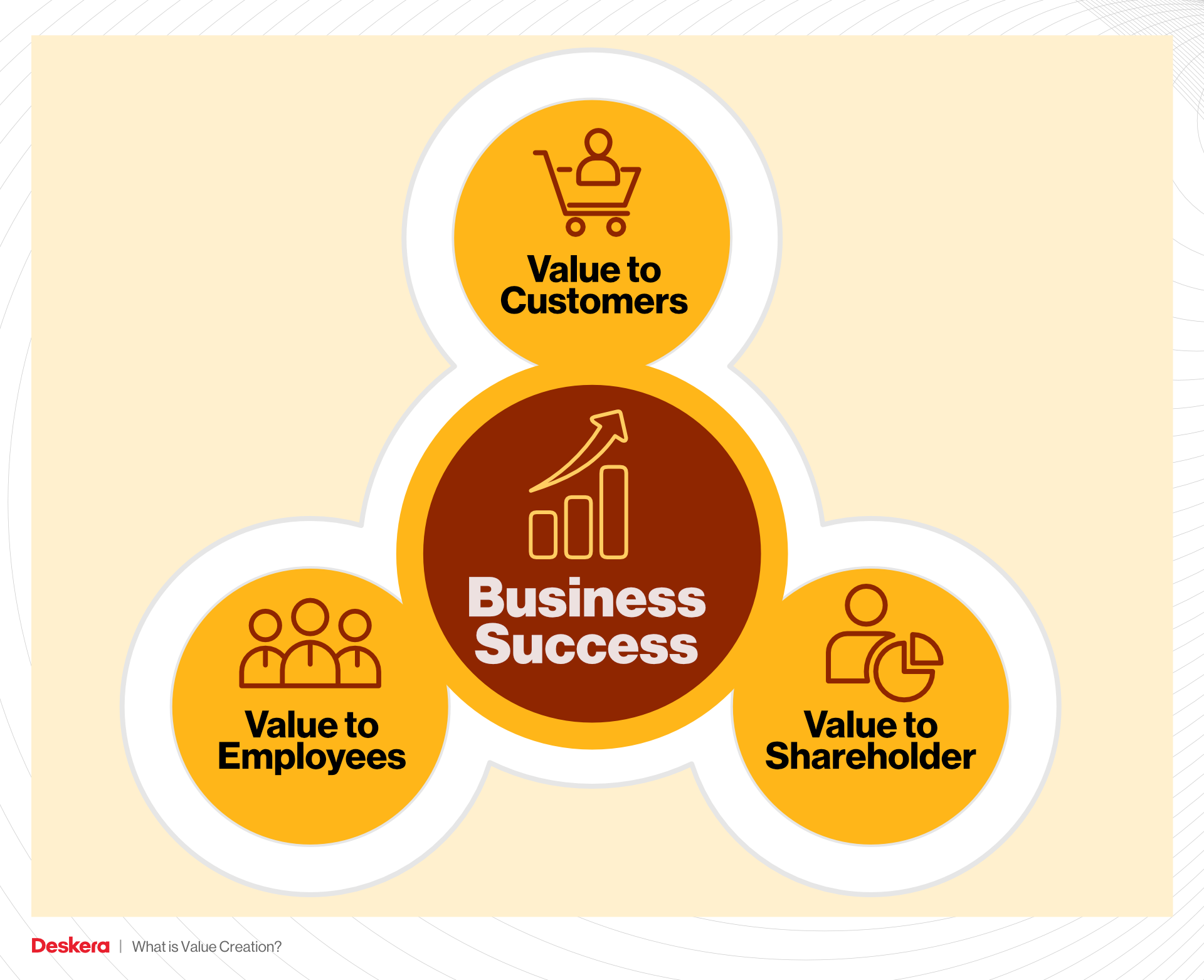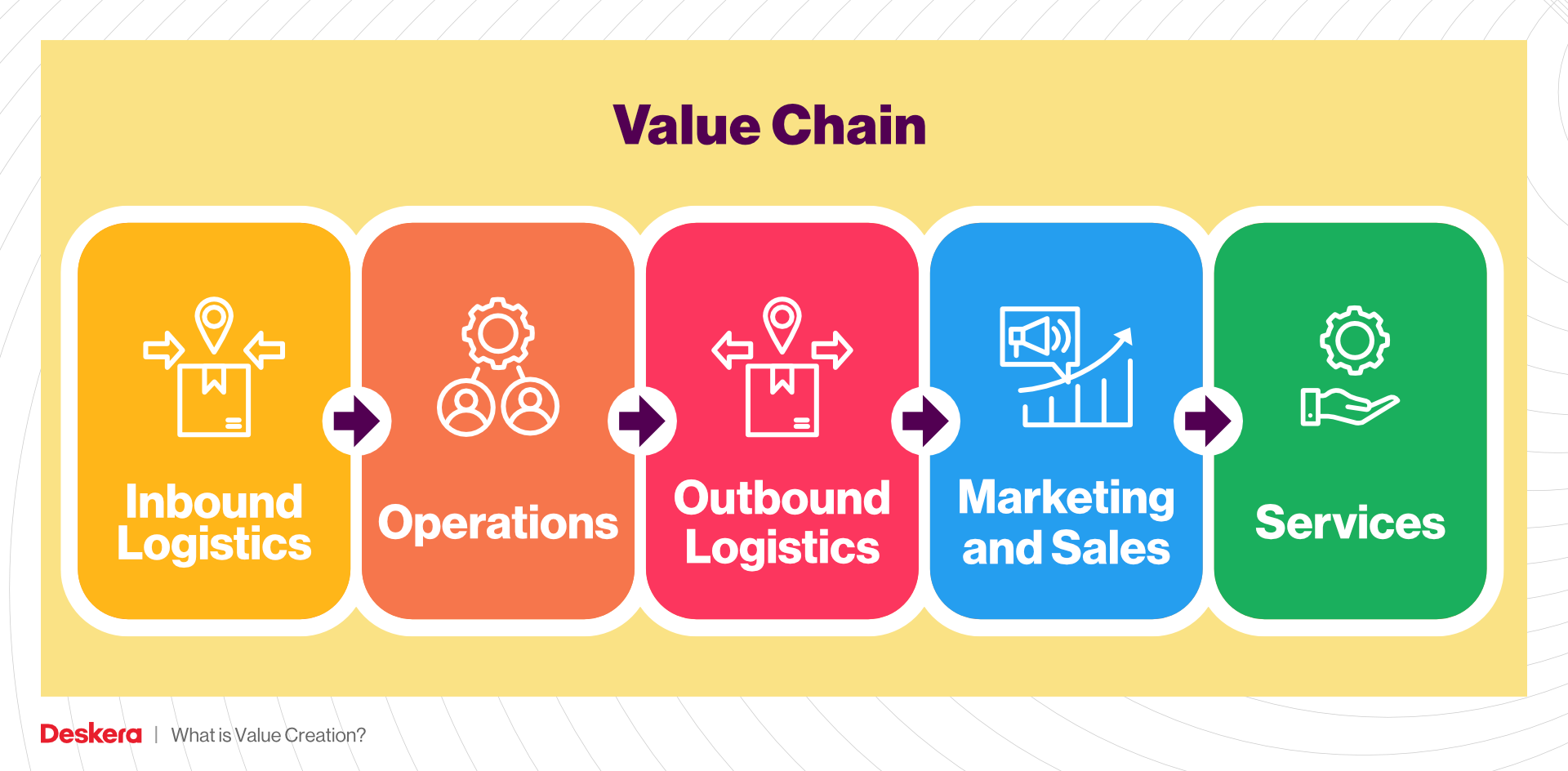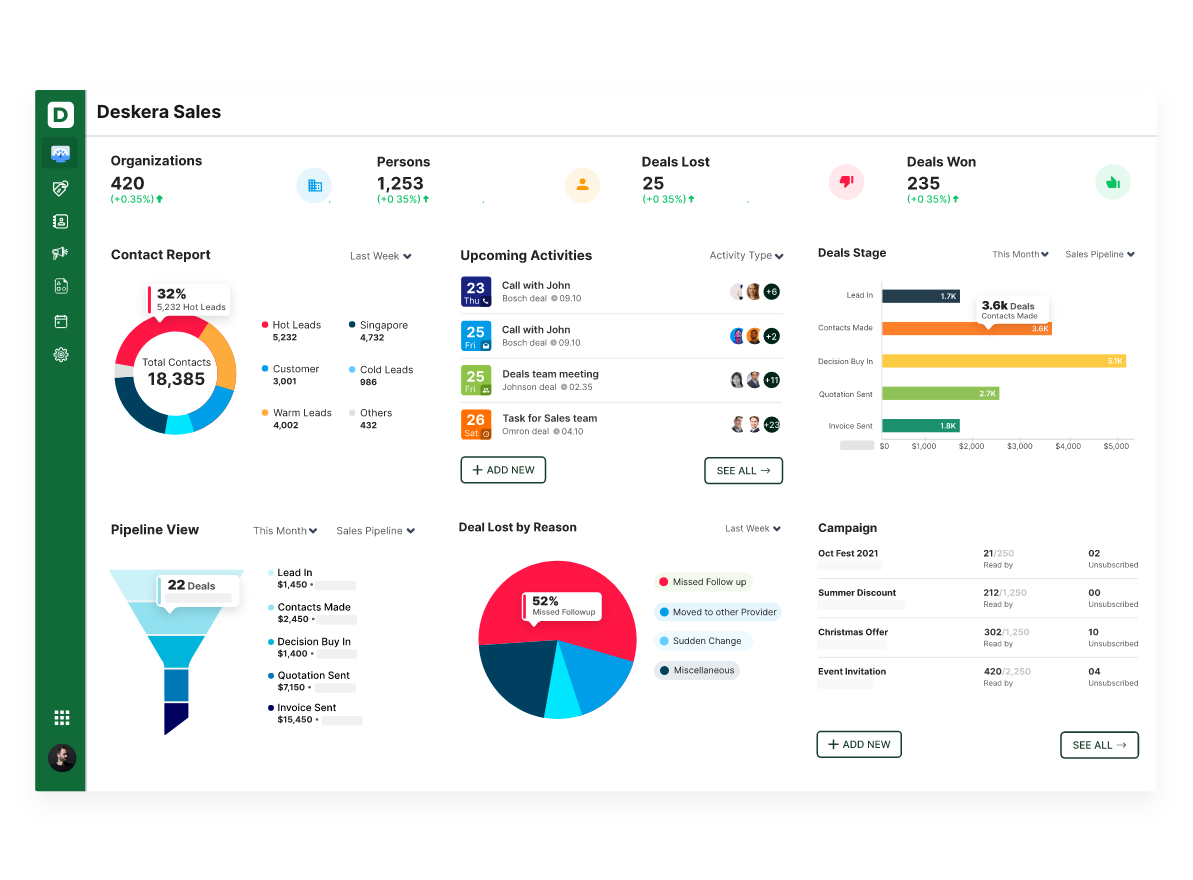The primary purpose of every business is to maximize profit. However, to do it without creating value is a step in the wrong direction. Value creation is an essential base to support a profitable and lasting business.
Value creation for customers helps sell products and services, creating value for employees results in higher efficiency and creating value for shareholders translates into increase in stock price, future guarantee of investment capital.

While the main focus is certainly to provide value to customers, it will be difficult to fulfill it if you don’t have the right employees working for you or stakeholders involved in the planning process.
Since value creation in business is much more than meets the eye, we have prepared this article that will answer all your questions.
This article will explore the following areas of value creation:
- What is value creation?
- How is value defined?
- What is the value creation chain through business?
- How is value creation measured?
- Value creation as revenue.
- Exchange value v/s perceived use value
- How does value creation lead to business success?
- Benefits of value creation
- Tips to improve value creation
- What will value creation look like in future?
- How can Deskera help?
What is Value Creation?
Value creation is the starting point for every business small scale or large scale. It entails making products and providing services that customers find consistently useful. It is a product or service that they build a bond of loyalty with.
In today’s economy, such value creation is based on four things. The product, process innovation, and fulfilling unique customer needs with not only speed but precision as well.
“In the real world outside of economic theory, every business is successful exactly to the extent that it does something others cannot.- Peter Thiel”
Value creation is not the matter of selling, cajoling, or convincing your buyer to buy something, but simply by its existence, in its complete, proper form catering to customer needs, customers will want to buy your product. As a result this instantly makes marketing and sales easier for a company.
Now, for example, Apple has been in the business of “delighting” its customers since 1997. They are not in the business of just creating gadgets but in the business of creating and retaining customers. Customer retention for Apple speaks volumes, not just figuratively but literally. Survey reveals the brand loyalty for Apple is at an all-time high of nearly 92%.
Apple is still a big player in the market, as of for a small business, value creation plays a larger role, its your stepping stone to success and more sales. While value creation is certainly important for your growth, here is an article proven ways to increase sales in a small business, to help you with your business. Or if you are looking for some quick but effective tactics to get you your maximum deals, here is another article you must read- Proven sales tactics for your small business.
If this is what your existing company or soon-to-be-established company is looking for, we have a ton more about value creation in the upcoming sections. To start with, let us find out how value is defined.
How is Value defined?
As we have already established, we cannot decide the value of our business. The value of your business is defined by customers, investors, employees, suppliers, and other stakeholders.
Defining value involves building up and focusing on your stakeholders. You must see how they are relevant to the motives, purposes, and techniques of your company. Then find a way to fulfill what their expectations are from you. By doing this, you will have a viable partner commitment that permits a more vast perspective, generally accurate to the versatility of the business.
Engaging stakeholders closely with your sales process and business, help with a more structured capital allocation. This is because your stakeholders understand where to exactly put their money and how much to invest. They understand the value of your sales and allocate the budget on the basis of the same.
Stakeholder Engagement Standard 2015 provides practical guidance on how to assess, design, implement and communicate effective stakeholder engagement, as well as how to enable stakeholders as active contributors to value creation.
Meaningful engagement with key stakeholders enhances understanding of the positive and negative impacts of doing business. Moreover it consequently informs a continuous assessment of the material issues informing strategy and its implementation through the activities in the business.
What is the Value Creation Chain Through Business?

Value creation chain alludes to the different business exercises and cycles engaged with producing, manufacturing a product or service. A value chain comprises various phases of production or service lifecycle, including innovative work, deals, and everything in the middle.
Your organization's value chain can assist you with acquiring knowledge into what goes into every deal made. By boosting the value made at each point in the chain, your organization can be better situated to impart more worth to clients while catching a more noteworthy offer for itself.
Likewise, realizing how your firm makes value can empower you to foster a more noteworthy competitive advantage as compared to the rest. A value chain is a bunch of exercises that an association completes to make an incentive for its clients. Porter, a Harvard professor, proposed a universally useful value chain that organizations can use to inspect their work in general, and perceive how they're associated.

The manner in which value chain exercises are performed decides expenses and influences benefits, thus it can assist you with understanding the benefits of significant value of your organization.
Rather than looking at departments or accounting cost types, Porter's Value Chain focuses on systems, and how inputs are changed into the outputs purchased by consumers. Using this viewpoint, Porter described a chain of activities common to all businesses, and he divided them into primary and support activities, as shown below.
Instead of taking into account different departments in the company, checking out bookkeeping costs is what Porter's Value Chain centers around. and how sources of info are changed into the yields bought by buyers. Utilizing this perspective, Porter portrayed a chain of exercises normal to all organizations, and he isolated them into essential and backing exercises.
Value creation chain serves you the opportunity to check your primary and secondary business functions and identify ways to improve efficiency, increase value and stand out in the market, winning the competitive advantage.
To make sure value creation is deep rooted in your company and all the teams are working for it, you can include value creation in your sales funnel as part of one of the stages.
Here are a few more benefits of value creation chain that you must be acquainted with.
Benefits of Value Creation Chain:
- Detect points of ineffectiveness for corrective action
- Optimize activities to maximize output
- Minimize organizational expenses
- Create cost advantages over competitors
- Detect and understand major competencies along with the points for improvements.
- Employees are more motivated to carry out the sales.
You can also refer to our article 23 Ways to Motivate Your Sales Team - Sales Motivation Guide for 2021, to help your teams maximize sales this year.
What you must remember undergoing value creation chain through business is, you must regard the framework as a starting point rather than a complete start-to-finish process.
Let us take an example of Amazon to understand the value creation chain to help you understand the concept effectively.
Inbound logistics:
Amazon's primary inputs can be identified as products sold through its own fulfillment services, as well as data center resources that fuel Amazon Web Services (AWS) cloud offerings.
Here, Amazon can use its size as a large operation to lower the costs per unit of items it purchases from external suppliers.
Operations:
This is where Amazon transforms its inputs into outputs. Amazon's core offering, its online marketplace, offers a secure platform that makes e-commerce easy for both customers and sellers.
As Amazon's fulfillment and logistics can offer two-day shipping to Prime members, the result is a secure, user-friendly customer experience with dramatically lower shipping times than competitors for a similar price point.
Another Amazon business unit, AWS, transforms inputs into outputs by creating and maintaining cloud servers, storage and other data center resources into a streamlined service for client organizations to host applications and other data.
Outbound logistics:
Amazon's outbound logistics includes Amazon fulfillment centers, digital delivery, co-sourcing and outsourcing, and brick-and-mortar stores.
Amazon's 109 fulfillment centers incorporate the use of robotics for fast, cost-efficient warehouse labor. Amazon's two-day shipping is a major distinguishing point over the competition.
Co-sourcing and outsourcing agreements allow Amazon to scale beyond the capacity of its in-house fulfillment services. Some services may be delivered digitally such as the software for Amazon's online marketplace and AWS cloud services.
Brick-and-mortar stores include Whole Foods and various Amazon retail stores. These physical retail spaces also contribute to other Amazon primary activities, such as service.
For example, online returns can be dropped off at certain Whole Foods locations, Kohl's department stores and UPS locations. Furthermore, customer service representatives in these stores are easily accessible for customers who would prefer to receive help in-person.
Marketing and Sales:
According to Statista.com, Amazon spent approximately $22 billion in marketing and advertising costs in 2020, using the financial power of a company of its size to maintain its role as one of the most recognizable brands today.
Services:
Amazon’s mission to be the most customer-centric company, Amazon is known for its simple and easy return process, as well as its high customer satisfaction ratings for AWS cloud service.
To help you understand your value chain effectively we have a three step process.
Step 1:
Break each primary and secondary activity down into sub activities. Organizations can then analyze each function on a more granular level, to compare the financial return of each function to the time, effort and cost required.
Step 2:
Look for connections between sub activities. Often, the inefficiency of one activity or sub activity is linked to another. For example, an ill-advised HR hire can create issues that permeate into many different sub activities. Technology and inbound operations can also have rippling effects throughout a company's value chain.
Step 3:
Consider trends and patterns in the different sub activities and connections between sub activities, and evaluate for potential improvement opportunities in those particular points in the value chain.
Now that you have understood what the value creation chain in business is, let us find out how to measure the same.
How is Value Creation Chain Measured?
There are multiple ways to measure value creation chain or value chain analysis. It is possible to create comparisons between values created, in a variety of ways through different processes. To help you pick your process we have enlisted the two popular processes below.
- Value creation as revenue
- Exchange value vs. perceived use value
Value Creation as Revenue
We are starting with one of the most easy to measure value creation processes- Value creation as revenue. Value creation as measure ensures that the process of value is not worthless, in the case where someone is willing to pay for it.
In a normal market, value always translates into more revenue for the business. A business can always consider the profits earned as the customer’s value as the customer only pays over and above a standardized price when they’re getting more benefits than expected.
There is a unit to measure everything. In measuring value creation, your unit would be revenue. Revenue is the measure of value creation but not your profit. A company creates value without creating a profit and many do. However, not for long.
Even very big businesses can be bad businesses. For example, the US airline companies serve millions of customers and create hundreds of billions of dollars or value each year. Compare them to Google, which creates less value, but captures far more. Google brought in $50 Billion in 2012 as compared to $195 Billion Revenue for the airlines. - Peter Thiel
Another method to measure value creation is exchange value and perceived use value. Let us learn more about it.
Perceived Use Value
Perceived value is defined by customers, based on their perceptions of the usefulness of the product on offer. Total monetary value is the amount the customer is prepared to pay for the product. The perceived use value is determined individually by each of us, and is subject to change at any time.
If something is purchased by the customer, the customer perceives a consumer surplus, or they wouldn’t make the exchange. So the total value created is the price paid, and the perceived value of the consumer surplus.
Exchange Value
Exchange Value is realized when the product is sold. It is the amount paid by the buyer to the producer for the perceived use value. Revenue is a sufficient proxy for quickly evaluating value creation, but it isn’t a complete measure.
Now that you have a clear picture of what value creation is, how it works, and how to measure it, let us find out how it fuels your business to run a successful company.
How Does Value Creation Lead to Business Success?
It is essential for every company hoping to climb the success ladder to understand value creation and practice in their company. If the purpose of business is value creation, the mission of any company should be defined in terms of its primary value-adding activities.
Managers are expected to address shareholder wealth, earnings growth, and return on assets, but the most successful firms understand that those measures should not be the primary targets of strategic management.
Achieving attractive financial performance is the reward for having aimed at and hit the real target. As a result, maximizing the value created for the primary constituents of the firm.
There is no question that competition, like profit, is an important dimension that companies must be aware of and manage to successfully create value in the long run.
A company typically creates value for customers and superior returns for investors by producing goods or services that are better than their competitors’ at meeting a set of clearly defined needs for a specific set of customers.
So competition is a key variable in determining whether a product or service provides a differentiated benefit to the customer, and one that she is willing to pay a premium for.
However, competition should never divert management from the primary task of creating those benefits by understanding and anticipating target customers’ needs, excelling in product and process innovation, providing outstanding service, etc.
Thus, we need to think of competition not as a goal, It is essential base to support a profitable and lasting business. Without it, your customer retention and your bottom line will be threatened directly affecting the success of your company.
However, there are still many hyper-growth and scaling companies that tend to overlook the importance of value creation. Be it a business small scale or large scale, as your customer numbers grow, the impact of churn on your bottom line also takes a hit. So while growth stands the focus of your business, value creation is critical to maintain it in the longer run.
What you can start with is examining your sales processes at all stages of the customer life-cycle, starting with the top of your sales pipeline. You need to pinpoint customers that you can count on so you can effectively forecast revenue and avoid wasting your sales force’s time chasing after dead leads.
How you can create value for the success of the company is by empowering your sales team. By letting go of ill-fitting leads and prioritizing opportunities where your employees can really bring value is the first step to foster long-term relationships so that you generate sustainable and profitable revenue for your business.
A value creation process is about gathering different perspectives so as to achieve risk mitigation. Innovation is not the result of luck. It takes discipline, commitment, and hard work. A strong value creation process aims at making success inevitable.
Long-term growth and profitability in a business occurs when companies develop a continuous stream of products and services that offer unique and compelling benefits to a chosen set of customers. This means that to maintain industry leadership, a company must establish a sustainable process of value creation.
There are two ways of you can do it right. One is by creating value or two by relying on your self-interest and exploiting other major conductors of business.
It can either embrace the idea of pragmatic idealism, challenging itself to create value for customers, employees, and shareholders in a positive, win/win cycle. Or it can pursue a more narrowly defined and illusory self-interest by attempting to exploit the lack of perfect information held by the firm’s constituencies or by taking advantage of other inefficiencies in the market that allow the company to temporarily benefit at the expense of other parties and the economy as a whole.
The latter approach is increasingly unworkable, even in the short run, owing to the nature of the emerging information economy. With value creation you take a step closer to your business success, now let us understand some other benefits of value creation that you must be aware of.
Benefits of Value Creation
Having a long term perspective in practices and implications of value creation, companies can generate higher returns. It provides a chance to earn higher return than its cost of capital. This process will increase their revenue, and create their brand image in the market. Here is a list of benefits of value creation that you cannot turn your back at.
Increased Employee Retention
As the definition of value creation suggests that, value creation involves creating value for your team, maximizing the value for your support team, this directly translates to the increase in employee retention rate.
While the first step towards value creation would be to find employees who will feel a strong bond with your company, you need to create an environment that attracts those employees.
Your company culture should match the type of employee you want to employ, whether you opt for a by-the-book, strict workplace or a more casual, laid-back atmosphere.
If you can cultivate an environment where employees feel cared for and gratified, you'll already be ahead of a great deal of other bosses out there. Improving retention rates doesn't have to be difficult.
By having a focus on value creation and directly connecting with your employees, you'll be more likely to understand what they need to continue to help your business thrive.
Increased Productivity & Efficiency of the Company
There’s nothing more important to any business than its employees. If your employees are happy, their productivity will increase, and that’s exactly what you need to help your business grow.
Making small changes to habits will drastically improve the levels of productivity and office efficiency in your business. The value creation for your employees will allow you to get more quality work done in a shorter period of time as well as reduce the amount of time spent on unnecessary tasks. This will also help your employees to understand the sales psychology more efficiently.
Optimal Utilization of Natural Resources
When you are focused on value creation, trying to make the best out of the available manpower and provide the best to your shareholders, you cannot forget the natural resources used for manufacturing products.
Some of the natural resources and services which contribute to successful business operations do not appear on balance sheets because they do not have a monetary value.
As a result, they are often undervalued and planning decisions might overlook the business risks that reduced supply of those services could create. This includes disruption to supply chains, higher operating costs and changes in customer preferences.
By focusing on value creation you can protect and enhance ecosystems, directly or through your supply chain, you could also minimize such risks and benefit from lending policies that favor businesses which combine growth with environmental leadership. A track record of positive environmental action can also enhance the image of your business and make it more competitive.
Value Creation: Creating Culture of High Performance
Value creation is a set of behaviors and norms that leads an organization to achieve superior results. In a high-performing culture, employees are motivated, productive, and engaged.
Due to the trust and respect inherent in high-performance cultures, employees feel empowered to take part in decision-making processes and freely contribute ideas and share feedback.
High-performance cultures are characterized by highly engaged employees who are trusted to complete the tasks of their roles. What a high-performance culture is not is cutthroat or toxic. All you are after is creating value and not just profit.
The attributes that contribute to a high-performance culture employee well-being, communication, trust, support, alignment of values, and emphasis on development are antithetical to a toxic workplace. Like any new or ongoing initiative, building a high-performance culture can feel overwhelming. But by value creation you can have a high performing culture rather easy.
Creating More Jobs
Countries today are striving to work on their employment rates. For a higher economy rate it is essential for every country to have zero unemployment rate. With value creation as the focus of your company you can contribute to that on a large scale.
Companies like Cisco, Google, and Amazon, and many more companies today, hire people from all over the country on a monthly basis. These companies also happen to have the lowest turnover rate. This is because of the value that they have created for their employees.
US and European companies that created the most shareholder value in the past 15 years have shown stronger employment growth.
Their idea is to create an environment that an employ loves, feels comfortable in and can further contribute to make it better for others. This as a result does not just improve the company culture but in the end helps the companies make profit.
Provides a Long Term Financial View
When you are starting out on a small business and you have partners that are ready to invest, what your agenda is to create so much value for them that they not only invest on your small projects but help you figure out the big ones and invest on it.
There is some money you invest as the owner and then there is a lot that you expect from your shareholder. What you need to do to make sure you have a free flow of cash from their end is by involving them in your decision making.
It is one way to have a financial view of your company. Wondering how? When you have your shareholders sharing their inputs on your projects they suggest you ways in which you can make it big and so can they.
In this way, not only that you have strategies easy, but you have an overview of what your financial scenario is going to look like in the long term. You have to balance between your ideas and what your shareholders are looking for.
This may seem like a good practice just for small companies, but even for the already established companies, you can make the best out of creating value for your stakeholder.
More Cooperation
A company in a value chain would work with other producers, processors, and retailers to create a better connection with customers. The relationships in the value chain work to maximize value for customers. These companies also maximize their profits.
Return on Investment
Whether a business is a producer, supplier, processor, distributor, retailer, it will seek a ROI for its participation in a value chain. Remember that the success of the value chain depends on the ability of its different members to work together towards common goals such as increasing product value for customers.
Enables SWOT Analysis
Value creation helps in understanding the organization issues involved with the promise of making customer value commitments and promises because it focuses on attention or the activities needed to deliver the value proposition. It helps you to detect the strengths of your company, the opportunities that you can cease, and threats that you can avoid/overcome.
Tips to Improve Value Creation
Improve customer support
Customers value businesses and organizations that focus on providing exceptional service and support. Evaluate your organization's current customer support processes and collaborate with teams on ways to improve these aspects of customer experience.
For instance, many companies implement both automated and professional support services that make it easy for customers to ask questions about products, troubleshoot issues and connect with businesses.
Promote value propositions
Identify your company's value proposition for its customers. The value proposition represents the value customers find in a product or service minus the costs of purchasing the offering.
For instance, the value of an offering may be higher for customers if they know they can rely on the offering over the long-term, resulting in a willingness to pay a higher cost for the quality they receive.
Creating and promoting the value propositions that are inherent to your company's products can help engage customers and inspire them to make purchases.
Increase convenience features
Create more convenient methods for customers to engage with your business, make purchases and use your organization's products more easily. For example, streamlining checkout methods within an online shopping platform or creating bundled offerings for related products are two ways that can make the customer experience more convenient.
Understand customer needs
Perform market analysis and learn about what your organization's customers look for when making purchases. Find ways to meet unique customer needs and create lasting value with your business's offerings.
With a deeper understanding of what your organization's market needs, you're more likely to create value through product offerings and building customer relationships.
Additionally, businesses that strive to fulfill customer needs are better able to build trust and rapport within the market, leading to repeat business and increased revenue growth.
Emulate competing prices and offerings
Evaluate competing organizations to determine what methods and products provide the most value to customer markets. Then, find ways to create similar offerings that are unique to your organization.
Another strategy to add value through similar offerings is by analyzing similar prices and modifying your selling prices to reflect the averages within your market. Creating alternatives to competitors can encourage new customers to purchase from your organization, boosting your business's value and giving value to its customers too.
Help teams develop effectively
Ensure sales, marketing and customer service teams have the necessary skills to boost value and reach customers. Sales training, professional development for customer service and workshops for skill building are all examples of how businesses invest in their staff to increase customer value.
With experienced and skilled teams, companies are better able to meet customer needs and provide offerings that create lasting customer value.
Take advantage of technology
Use technological approaches to manage customer experience, customer relationships and customer support. For instance, many businesses integrate software or other technical applications to track and maintain customer accounts and information. Automating various processes to help streamline customer service can also help you create value in your business.
Use the right tools and resources
Collaborate with team members to determine which resources and tools can boost overall customer value. For instance, customer surveys can give your organization important insight into purchasing behavior, product needs and improvement suggestions. This will also reflect your care and concern towards your customers.
Tools like surveys and market analysis can help your business increase the value it offers to customers and create a lasting business that leads to growth and success.
Improve product development
Make improvements in the product development processes of your company. Use data from market analysis and evaluating customer demographics to support designing and planning new products that meet demands.
Address customer concerns and input to find methods of development that produce high-quality offerings that customers are willing to purchase. By improving the product development cycle, you can create offerings that give more value to customers.
Make advantageous investments
Learn where to invest company funds to support growth and add value to the business. For instance, evaluate which marketing strategies are the most successful at providing substantial returns on investment (ROI) so you can understand what methods reach customers most effectively.
Similarly, investing in sales and customer service training for your teams can also add higher value to your organization.
What Will Value Creation Look Like in Future?
Value creation historically has been a great force in the best of the public. There are many trade-offs that company managers struggle to make, in which neither a shareholder nor a stakeholder approach offers a clear path forward.
This is especially true when it comes to issues affecting people who aren’t immediately involved with the company. However, the interests of shareholders and stakeholders can go hand in hand.
Businesses make a vital contribution by creating value for the long term. Doing so in a sustainable manner calls for meeting the concerns of communities, including the environment, consumers, employees, suppliers, and shareholders alike.
A short-term focus necessarily shortchanges some or all of these constituencies. A long-term commitment toward value creation, by contrast, almost axiomatically takes a broad range of constituent interests into account.
Value creation in the future will be based on economies of creativity, mass customization and the high value of bringing a new product or service improvement to market.
Organizational structure will have to change to meet the new reality of creativity as a core component of value and continuous innovation as the mechanism to sustain it.
The new organization will include structures that support innovation 24/7/365 and at increasing scale be it by inside sales or outside sales. They will be more like organisms than machines. They’ll be structurally fluid. It will bring individuals together in creative networks designed to adapt to an ever changing landscape of customer needs and desires.
How you can contribute to creating value in your business is by putting your most powerful resource, technology to your best use. Understand how machines, technology works and how to apply it to whatever you are doing will free you up to start thinking about how you add creative value. That creative value may well be organizing the machines to manifest a creative product or service.
You must also start getting your people together regularly to think about how to add value to your customers and to your organization and make this time sacrosanct.
Make it clear that your organization is beginning a long term process of embedding innovation into your DNA; that creativity is the new effort and innovation on a continuous basis is the process to make it real: this is what the organization is about and does, and will be the primary responsibility of everyone in it.
Lastly, remember that value creation does not happen in a day, it takes time, all you need to do is start working on it from now. What we can do to help you is offer a one stop solution like Deskera. Let us see how Deskera helps in value creation for your business.
How Can Deskera Help?
As a company that believes in creating value for its customers, employees, and shareholders, Deskera is on the journey to help other companies offer the same to their stakeholders and customers.
Using the Deskera CRM system, you can manage your contacts, leads and reporting. You can use the CRM system to manage all customer data and reports. Deskera makes sales reporting easy.

Doing so will help you to save the time taken in transferring customer data between the different systems. It will also assist you with real-time updates about your business like cash flow status, customer satisfaction, inventory management, sales, purchases, purchase orders, customer tickets, customer satisfaction, managing leads, revenues, profit, and loss statements, and balance sheets.
Moreover, it would also help in integrating sales methodology across different platforms onto one system so that you have a consolidated list for email campaigns, leads management, and sales pipeline to mention a few.
It will also help you to sync between your orders, payments, taxes, refunds, product variants, sending out invoices and reminders, facilitating invoice management, and even undertaking follow-ups and advertisement campaigns.

Deskera also offers some impeccable features that will help you create value for your employees. Just create and customize your ideal sales pipeline with a few clicks, you can start with Deskera Sales. Deskera Sales is a CRM software that helps small to medium businesses build a sales pipeline that suits their business needs.
Here is a quick demo to help you understand how Deskera helps:
On top of that, you can also create multiple customizable pipelines for different teams in the organization. Isn't that all you are looking for?
Another advantage that Deskera has over other software is Deskera CRM+. This software is equipped with templates for your landing pages and a landing page dedicated dashboard for tracking their performance. In addition to this, through Deskera CRM’s dashboard, you can track your marketing KPIs in order to find the one that is most effective in meeting your goals. The marketing KPIs would also be able to track the performance of the CTAs that you use on your pages to generate more leads through useful resources.
Key Takeaways
- Without value creation, businesses wouldn't be in business at all.
- Value creation is the bedrock of business. It’s what sets you apart from your competition, secures long-term customers, and brings distinct meaning to your brand and your solution.
- Achieving continued growth while still providing genuine value to our prospects and customers is a huge challenge.
- Defining value involves building up and focusing on your stakeholders.
- Value creation chain alludes to the different business exercises and cycles engaged with producing, manufacturing a product or service.
- Value chain helps to detect points of ineffectiveness for corrective action, optimize activities to maximize output, minimize organizational expenses, create cost advantages over competitors.
- The value creation for your employees will allow you to get more quality work done in a shorter period of time.
- Identify your company's value proposition for its customers.
- Learn where to invest company funds to support growth and add value to the business.
- Perform market analysis and learn about what your organization's customers look for when making purchases.
- Create more convenient methods for customers to engage with your business, make purchases and use your organization's products more easily.
- Value creation in the future will be based on economies of creativity, mass customization and the high value of bringing a new product or service improvement to market.
- Start getting your people together regularly to think about how to add value to your customers and to your organization.
Related Articles:












